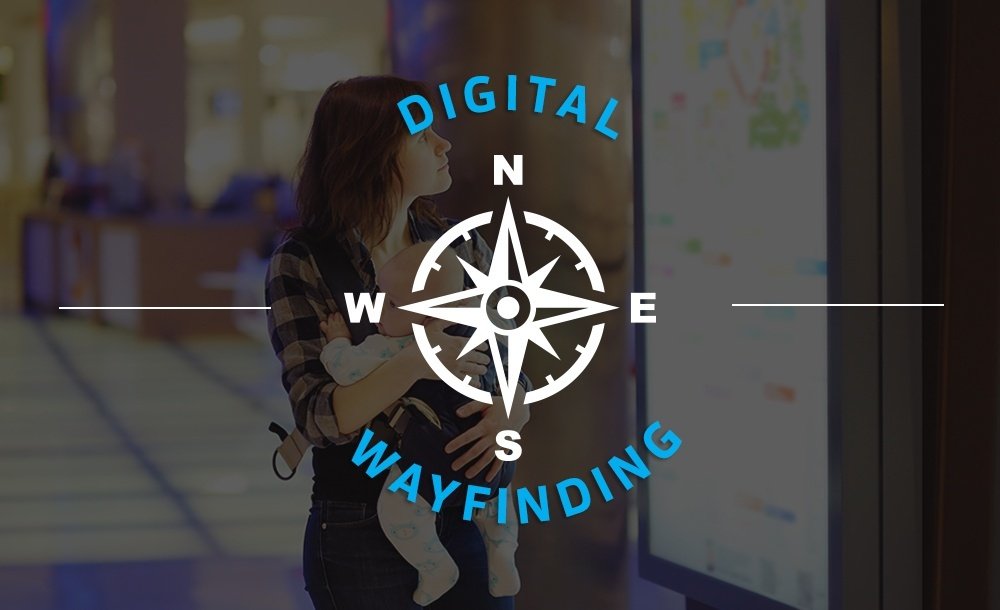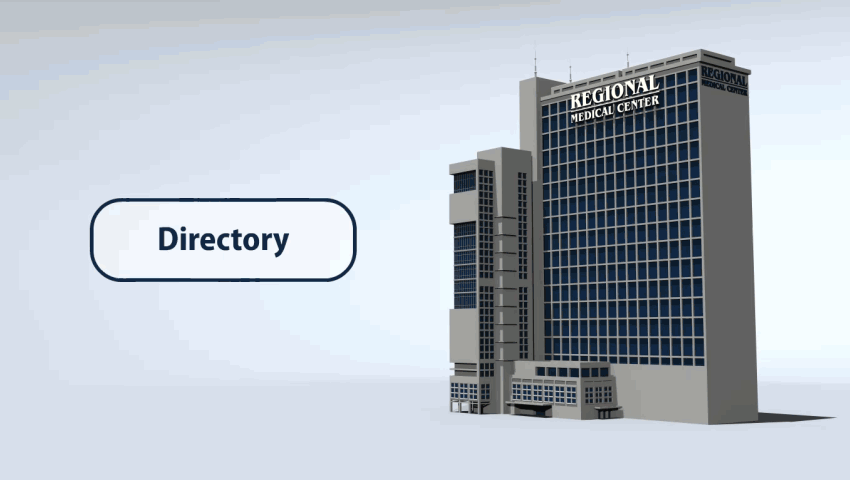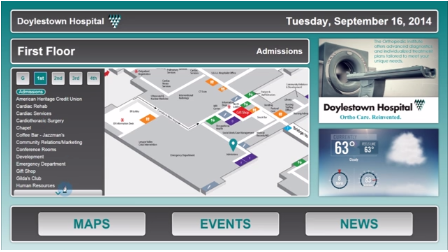
Few things are as frustrating as arriving at a location or facility and struggling to find what you need.
Whether it’s visiting a commercial store where you need to find an item to purchase or a stadium where you need to find your seats or worse, a hospital where you need to find a loved one — it’s aggravating to wander around an unfamiliar location looking for something important.
So, why are you sending your customers or visitors on a search when they arrive at your location? Why are you making them search when you can easily guide them to what they need through the use of digital wayfinding maps?
Interactive Digital Wayfinding Maps
Digital wayfinding maps are interactive screens used within buildings and campuses to provide directional information and directories to visitors.
Unlike static maps and signs, interactive wayfinding technology allows the user to interact with a screen and see a video representation of how to get from one location to another, making navigation of a location much easier.
Users can also search through information so they can find what they need while filtering out the information they don’t.

Digital wayfinding maps are often placed near the entrance and throughout large buildings and campuses so guests can find directions when they walk in and as they need them throughout their visit.
Helping guests find their way is an obvious benefit of digital wayfinding maps, but these interactive maps do more than help visitors find their way.
What Are the Benefits of Digital Wayfinding Maps?
Digital wayfinding maps bring a variety of benefits to campuses and offices big and small.
Reduce Visitor Frustration and Improves Satisfaction: Guests are more satisfied with their experience at a location when they can find what they are looking for without wasting time or energy.
Reinforce Branding: Digital screens that feature your logo, colors, and branded graphics appear in front of guests each time they interact with your map, which helps reinforces branding and create lasting brand recognition.
Show Investment in Technology: Displaying interactive technology instead of dated, static media shows guests that your organization is committed to staying up-to-date with the latest technology. It positions your location as a premium and high-end store, shop, or facility.
Alleviate Stress on Human Resources: With digital wayfinding maps in place, organizations can rely less on human resources needed to guide guests. Maps can provide the customized information that visitors need.
Provide Directory Information: Interactive digital screens help guests find their way and the information they need. The technology can feature directories so guests can search for what they need and then receive directions to that location.
Clear Congested Hallways & Walkways: When guests know where they’re going, they are less likely to gather and stop in walkways. Traffic keeps moving when visitors know how to follow a direct path to their destination.
Share Emergency Messages: With screens placed throughout a location and synced with the same technology, digital wayfinding tools become a centralized communication tool that can quickly share emergency messages with an entire location via one platform.

Easily Update Information: Information on digital signage is easy to update and revise. Content management systems make it simple to change existing content with just a few clicks of a button.
Save Money on Updating Signage: The alternative to using digital wayfinding maps is using static print maps. With print maps, you need to purchase new versions each time you make a change. With digital maps, you can make changes at little to no cost.
Reduce Inconsistencies: Because you can easily and affordably update the information on a digital screen, you can make even the smallest changes to ensure that content is always consistent, relevant, and current.
Provide Supplemental Information: The content on a digital screen can be positioned so you can share information beyond directory and map details. Supplemental information like news, updates, and weather can be featured on the screens as well.
Offer Promotion Opportunities: Extra content fields on digital screens also offer an opportunity to display promotions for your location’s products, services, and upcoming events.
Create Income Opportunities: Marketing opportunities on a digital wayfinding map are not restricted to internal promotions. You can sell space on your screen to non-competing third-party advertisers to use your digital signage as an income generator.
Interactive Wayfinding Case Study: Grand Central Station
Imagine an interactive kiosk with a touchscreen interface that allows viewers to choose a destination, and then presents the exact route they’ll need to get there. It could also provide information about points of interest and alerts about the route. These kiosks are already in use at one of the busiest transportation destinations in the world: New York City’s Grand Central station.
The Metropolitan Transportation Authority (MTA) manages transit for New York City’s buses, subways, trains, bridges and tunnels throughout the city. The subway system alone transports almost five million people each weekday. Earlier this year, they installed eighteen, 47-inch kiosks, at the Grand Central station. The On the Go! Travel Stations offer customers information about their entire trip: trip planning, real-time service status, escalator and elevator status, and points of interests at their stop.
In addition to the positive customer feedback to the kiosks, the city isn’t even paying for them. The project is a collaboration between MTA and Control Group, a design and technology consultancy firm. The firm is footing the bill, hoping the kiosks will pay for themselves with advertising revenue.
Who Can Use Digital Wayfinding Maps?
A variety of industries benefit from the many uses of digital wayfinding maps. This interactive technology serves:
- Hospitals and Medical Facilities
- Resorts and Hotels
- Airports
- Malls
- Convention Centers
- Educational Campuses
- Arenas and Stadiums
- Residential Complexes
While the basic functions of wayfinding tools work the same for each industry, screens can be optimized to work best for the location’s unique needs.
Healthcare industries use digital wayfinding tools in a different way from residential complexes, which is why the tool is so powerful. Each digital screen can be customized to work best for the goals and facility environment so the location can provide their guests with what they need right when they need it.
Now, when you think about your location, what type of visitor experience are you providing?
Are you simplifying the visitor experience by providing guests with useful and vital information in an engaging way? Or are you confusing and frustrating guests by leaving them with dated, complicated, or unhelpful directions?
If you’re ready to improve the experience of your guests from the moment they enter your facility, store, or campus — start thinking about upgrading your wayfinding tools to a digital interactive platform.
Find out what it will take to bring your location into the next phase of technology by claiming a free, no-obligation digital signage consultation with our team of specialists. They’ll help you identify what you need to know to bring this new, exciting technology into your business or facility.